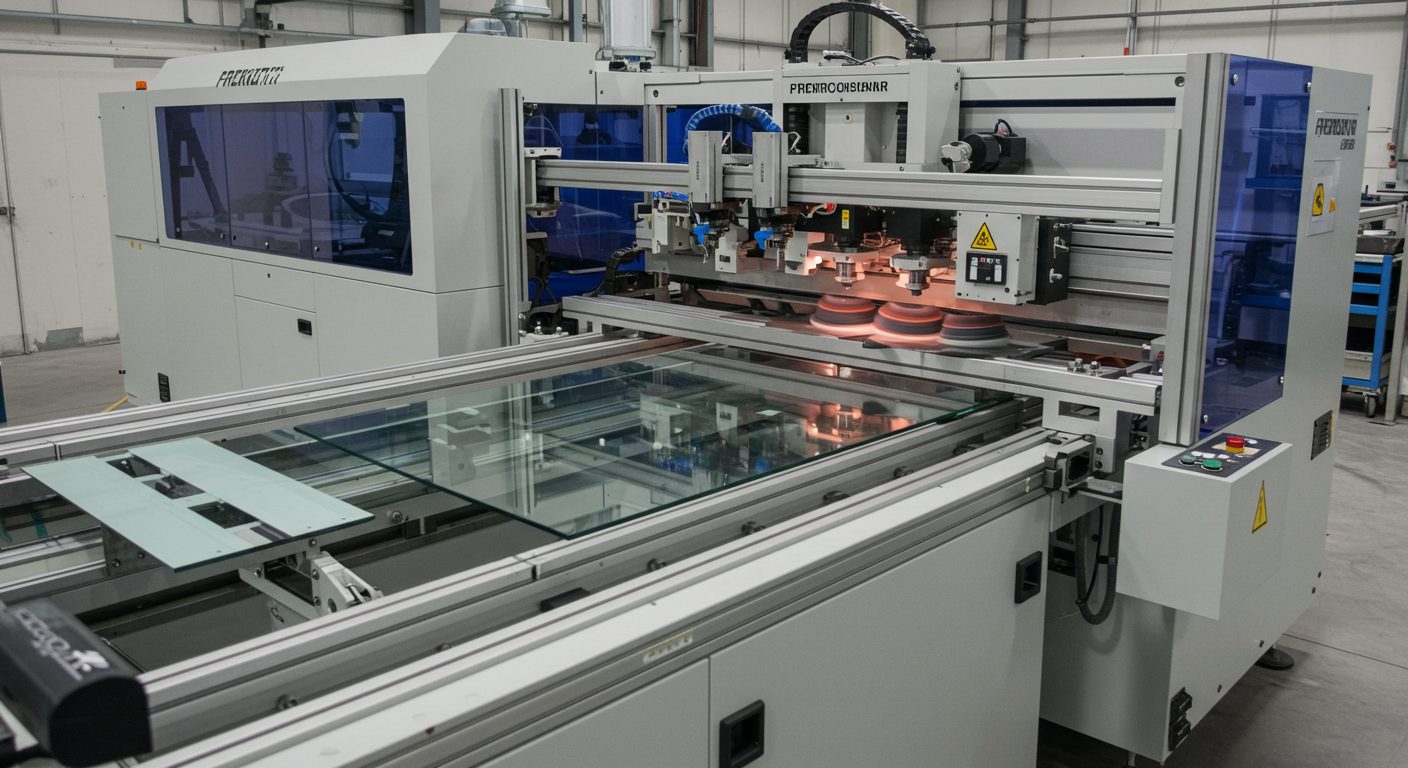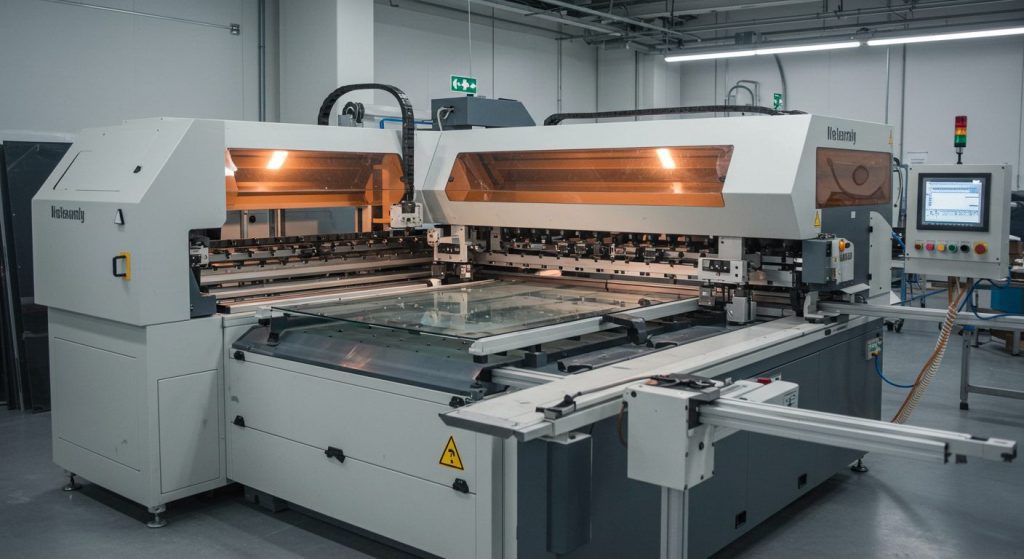Automotive Glass Beveling Machine| Guide for Your Business
2025/05/15 By admin

What is an Automotive Glass Beveling Machine?
- An automotive glass beveling machine is defined as advanced equipment that both machines and polishes the edges of glass used in vehicles like windshields, side windows, and rear windows. It is worth noting that beveling involves providing a certain predetermined angle to the edge of a glass by grinding, polishing, and shaping it into a contour that is aesthetically and functionally pleasing.
- Such machines possess specialized high-precision tools, usually CNC-controlled, that guarantee uniformity in results. The presence of automatic features allows consistent results, optimum efficiency, and minimum production time with automotive beveling machines.
5-Axis Glass Beveling Machine for Automotive Glass
A 5-axis glass beveling machine is a versatile equipment that specializes in the precise cutting and shaping of automotive glass. Such machines can move in five directions, thus the name 5-axis, which allows them to cut smooth angled edges of glass into intricate shapes on windows, mirrors, and windshields
Key Features:
• Precision: Engraving and surface etching will be done accurately and with fine detail
• Flexibility: Not limited to these complex designs, and can also work on simpler automotive glass designs.
• Broader Application: Suited for automotive glass and mirrors, decorative glass, tabletops, and other such items, and in differing environments.
What is the Working Principle of an Automotive Glass Beveling Machine?
The beveling process can be defined as shaping the edge of the glass to an angle between 15 to 45 degrees. An automotive glass beveling machine functions based on its main features:
1. Grinding and Shaping: Glass pieces are inputted into the machine where they are subjected to high-speed grinding wheels, which grind the edges to the required bevel.
2. Polishing: In the post-grinding phase, the edges are polished. This step is especially important in preventing sharp edges that may be harmful.
3. Chamfering and Edge Treatment: Certain machines do further chamfering or veering (arising), which adds aplomb to the edge detail of the beveling process.
Why is There a Need for Automotive Glass Beveling?
It does not require any form of digression; that automotive glass beveling does come in handy. Here’s one of the pointers elaborating more on its benefit:
1. Smooth Integration
Aesthetically, beveled glass windows provide a fitting frame to the vehicle’s interior while simultaneously masking the crude parts of the glass, which smoothly integrates with the frame of the vehicle. Beveled edges not only aid in enhancing the arcs of the glass, improving its attributes, but also make a better impression on the vehicle, whether it be for luxurious cars or fairly ordinary ones.
2. Durability
A glass edge that has been properly polished will not crack or chip over time. In addition to these factors, the polished edge reduces the risk of damage during handling or installation.
3. Safety
Individuals not operating the vehicle or using it as a passenger are better safeguarded by the glass featuring beveled edges. Sharp edges can be dangerous, but the design of the glass makes installation and handling easier, minimizing the chances of accidents in conjunction with sharp edges.
4. Precision
The application of beveled glass edges for automotive glass can be done by automated systems such as CNC glass beveling machines. Such systems ensure that the bevels are done uniformly and accurately on large quantities of automotive glass. Uniformity needs to be maintained for multiple vehicle models of a single brand to retain the same standard of excellence or quality

Automotive Glass Beveling Process: What it Entails
The automotive glass beveling procedure comprises various activities that can be done in steps. It can be organized as follows.
Step 1: Loading Glass Sheets
Depending on the type of beveling machine, glass sheets can be manually or automatically placed on the glass loading table on the machine.
Step 2: Edge Grinding
To polish glass parts, material is removed from the edges using high-speed grinding wheels. The edge of the glass is beveled or rounded off at an angle between 15 degrees and 45 degrees. Depending on the model of the vehicle, the angle may have different specified values.
Step 3: Edge Polishing
After edge grinding, polishing is done on the edge face using a polishing wheel or belt. This process smoothens the edges, making them easy to grab and pleasant to look at. Polishing also enhances appearance by removing rough edges.
Step 4: Inspecting Polished Edges for Quality
The last step in the process is verifying that the bevels are accurate. During this stage, smooth surface edges and contours that match will be checked for some defects, like cracks or chips.
Benefits of Using Automotive Glass Beveling Machines
Purchasing a high-grade automotive glass beveling machine can provide manufacturers with several benefits.
1. Increased Efficiency
Automated glass beveling systems are faster and more efficient than their manual counterparts. These machines can shred multiple pieces of glass simultaneously, which increases sheet throughput while simultaneously decreasing production speeds.
2. Enhanced Precision
Every piece of glass receives equivalent beading around the edges, which is extremely important in glass used for cars, due to the automation of CNC-controlled machines. Uniformity is assured in all items. Such painstaking care guarantees high standards of quality for car gears.
3. Cost-Effectiveness
Owning an automotive beveling machine provides considerable long-term advantages compared to the significant initial investment. This machine aids in lessening manual labor, waste, and production cycle time.
4. Customization
With some advanced beveling systems, manufacturers can set specific requirements for automobiles that can include adjustments for angle modifications or specialized edge treatments. Customization provides flexibility in the production process.
Uses for Automotive Glass Beveling Machines
These machines are integral in various parts of the automotive manufacturing process. Here’s where they fit into the broader automotive industry:
1. OEM Automotive Glass Production
Original Equipment Manufacturers (OEMs) have been equipped with automotive glass machines that provide precise and exact cutting of master glass into windows and doors of vehicles. This machine guarantees that every glass produced is of high grade and meets all standards.
2. Aftermarket Auto Glass
Aftermarket industries use these beveling machines to process replacement windows for vehicles. Just like the OEM glass, aftermarket glass has to meet the set standards of quality, thus, precise processing using the beveling procedure is needed.
3. Personalization for Luxury and Premium Vehicles
Window beveling for luxury vehicles is typically solicited by high-end automobile manufacturers. The glass windows of luxury models can be programmed to meet beveling, cutting, and edge polishing requirements as they undergo further specialized automotive glass beveling machining.
Important Aspects of an Automotive Glass Beveling Machine
The choice of a machine should take into account the accuracy of the model’s performance features. Here are some of the industry requirements you must comply with.
1. Accuracy
It is recommended to make use of machines with high and repeatable measurement accuracy. This is achieved with a CNC control system.
2. Automation
The time-saving and cost-efficient qualities of these machines boost business productivity, making them the best choice for mass production.
3. Strength
It is best to select an automotive beveling machine that is built to withstand misuse, as these machines are subjected to considerable abuse.
4. Customizability
The manufacturability of the machine can be affected by the flexibility of the size and shape of the glass, the level of detail that can be added, and the results that are achieved.
Conclusion:
As with many other technological advancements, the automotive glass beveling machine has become more sophisticated. It is clear from the increased precision, such as CNC control and automation, that these machines are designed with the intricate specifications of the automotive industry in mind. As experts in glass processing, we endeavor to meet and exceed your expectations and needs, so do not forget to check BAINENEG for automotive beveling machines.
TRENDING POSTS
- Glass Shape Edging Machine Product Solution 2025/05/15
HOT TOPIC
- architectural glass beveling machine
- automatic glass beveling machine
- Automotive Glass Beveling Machine
- cnc engraving machine manufacturer
- CNC glass beveling machine
- cnc glass edge polishing machine
- CNC glass grinding machine
- CNC Machine for Sale
- CNC Machine Manufacturing
- CNC Machining Center
- decorative glass beveling machine
- glass beveling and polishing machine
- glass beveling equipment
- glass beveling machine distributor
- glass beveling machine for sale
- glass beveling machine manufacturer
- glass beveling machine price
- glass beveling machine supplier
- glass door beveling machine
- glass edge beveling machine
- glass edge chamfering machine
- glass edge finishing machine
- glass edge grinding machine
- glass edge polishing machine
- glass edge processing machine
- glass edge shaping machine
- glass edge smoothing machine
- glass edge trimming machine
- glass furniture beveling machine
- glass panel beveling machine
- Glass Shape Edging Machine
- glass window beveling machine
- mirror beveling machine
